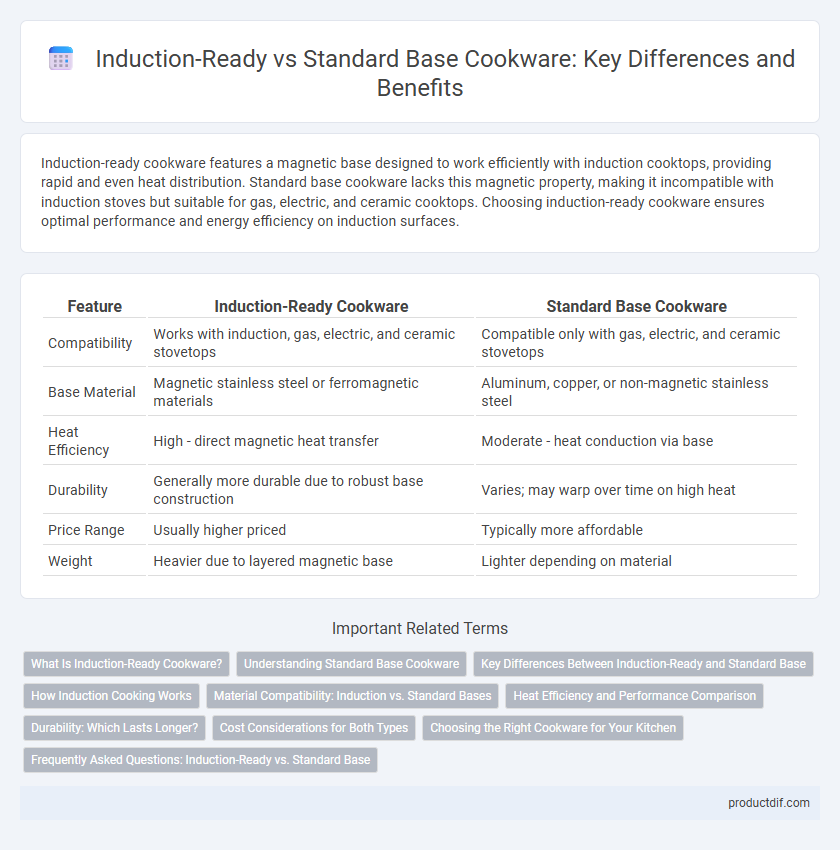Induction-ready cookware features a magnetic base designed to work efficiently with induction cooktops, providing rapid and even heat distribution. Standard base cookware lacks this magnetic property, making it incompatible with induction stoves but suitable for gas, electric, and ceramic cooktops. Choosing induction-ready cookware ensures optimal performance and energy efficiency on induction surfaces.
Table of Comparison
| Feature | Induction-Ready Cookware | Standard Base Cookware |
|---|---|---|
| Compatibility | Works with induction, gas, electric, and ceramic stovetops | Compatible only with gas, electric, and ceramic stovetops |
| Base Material | Magnetic stainless steel or ferromagnetic materials | Aluminum, copper, or non-magnetic stainless steel |
| Heat Efficiency | High - direct magnetic heat transfer | Moderate - heat conduction via base |
| Durability | Generally more durable due to robust base construction | Varies; may warp over time on high heat |
| Price Range | Usually higher priced | Typically more affordable |
| Weight | Heavier due to layered magnetic base | Lighter depending on material |
What Is Induction-Ready Cookware?
Induction-ready cookware features a magnetic base designed to efficiently transfer heat on induction cooktops, ensuring faster and more even cooking. These pots and pans typically contain a layer of ferrous metal, such as stainless steel or cast iron, allowing them to work specifically with induction technology. Unlike standard base cookware, which may not respond to magnetic fields, induction-ready options provide compatibility and superior energy efficiency for induction stovetops.
Understanding Standard Base Cookware
Standard base cookware features a single-layer construction typically made from aluminum or stainless steel, which offers moderate heat conductivity but is not compatible with induction cooktops. Unlike induction-ready cookware that requires a magnetic base, standard base pots and pans rely on direct heat transfer through the material itself, making them suitable for gas, electric, and ceramic stoves. Understanding the limitations of standard base cookware is essential for selecting the right pots and pans based on cooking surface compatibility and heat distribution preferences.
Key Differences Between Induction-Ready and Standard Base
Induction-ready cookware features a magnetic base compatible with induction cooktops, enabling rapid and efficient heat transfer, while standard base cookware lacks this magnetic property and is suitable only for gas or electric stoves. The key difference lies in the base material: induction-ready pans use ferromagnetic metals such as stainless steel or cast iron, whereas standard base cookware often employs aluminum or copper, which are non-magnetic. This distinction affects cooking performance, energy efficiency, and compatibility with various stovetops, making induction-ready cookware essential for induction technology users.
How Induction Cooking Works
Induction cooking operates through electromagnetic fields that heat the cookware directly, requiring pots and pans with magnetic materials such as cast iron or stainless steel. Induction-ready cookware features a specially engineered base, often layered with magnetic metals, to ensure compatibility with induction cooktops. Standard base cookware lacks this magnetic property and cannot generate heat efficiently on induction surfaces, making induction-ready options essential for optimal cooking performance.
Material Compatibility: Induction vs. Standard Bases
Induction-ready cookware features magnetic materials like stainless steel or cast iron, essential for compatibility with induction cooktops that generate heat through electromagnetic fields. Standard bases typically use aluminum or copper, which offer excellent heat conduction but lack the magnetic properties needed for induction heating. Selecting cookware depends on the cooktop type: induction systems require ferromagnetic bases, while gas and electric stovetops support a broader range of materials.
Heat Efficiency and Performance Comparison
Induction-ready cookware features a magnetic base designed to rapidly generate and distribute heat directly to the pan, offering superior heat efficiency compared to standard base cookware that relies on less efficient conduction. This direct induction mechanism reduces cooking time and energy consumption, enhancing overall performance, especially for precise temperature control. Standard base cookware may experience uneven heat distribution and longer heating periods, making induction-ready options preferable for energy-conscious and performance-driven cooking.
Durability: Which Lasts Longer?
Induction-ready cookware features magnetic stainless steel or iron bases that resist warping and corrosion, offering enhanced durability compared to standard base cookware made from aluminum or non-magnetic metals. The multi-layered construction of induction-ready pots and pans often includes stainless steel encapsulation, which significantly extends lifespan by preventing base deformation under high heat. Standard base cookware, while affordable, tends to degrade faster with uneven heating and is more prone to damage, making induction-ready options a longer-lasting investment.
Cost Considerations for Both Types
Induction-ready cookware typically costs more due to specialized magnetic materials ensuring compatibility with induction cooktops, while standard base cookware is generally more affordable but lacks this feature. Investing in induction-ready pieces may lead to energy savings and faster cooking times, potentially offsetting the initial higher price. Consumers should weigh the upfront cost against the benefits of efficiency and versatility when choosing between the two.
Choosing the Right Cookware for Your Kitchen
Induction-ready cookware features magnetic bases composed of ferrous metals such as stainless steel or cast iron, enabling compatibility with induction cooktops that generate heat through electromagnetic fields. Standard base cookware, typically made from aluminum or copper without magnetic properties, works well on gas and electric stovetops but is incompatible with induction surfaces. Selecting the right cookware depends on your stovetop type; opt for induction-ready sets to ensure efficient heat transfer and energy savings on induction cooktops, while standard base options may suit conventional gas or electric ranges.
Frequently Asked Questions: Induction-Ready vs. Standard Base
Induction-ready cookware features magnetic bases compatible with induction cooktops, ensuring rapid and even heating, while standard base cookware is designed for traditional gas or electric stoves and may not work on induction surfaces. Common FAQs address how to test cookware compatibility with a magnet, the benefits of energy-efficient induction cooking, and whether non-induction pots can damage induction cooktops. Choosing induction-ready cookware enhances cooking precision and energy savings, while standard base options offer broader usability but lack induction functionality.
Induction-Ready vs Standard Base Infographic

 productdif.com
productdif.com